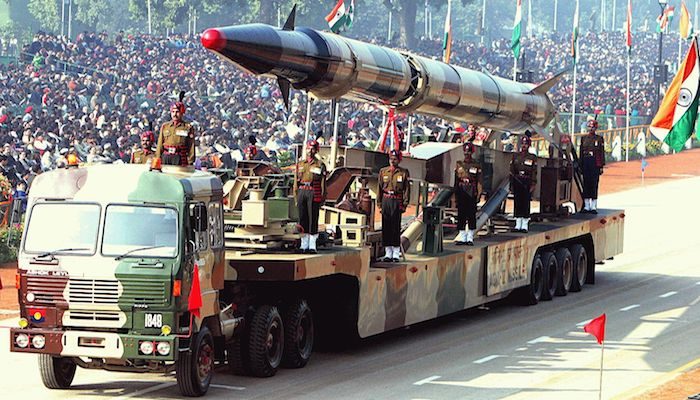
Image by Antônio Milena (ABr)
by Khawaja Dawood Tariq 13 May 2021
It was May of 1998 when India decided to demonstrate its nuclear capability and Pakistan was left with no choice but to follow the same suit. Consequently, this has turned an already contentious inter-state conflict into a nuclear flashpoint. In the last two decades, both states have considerably increased the size of their nuclear arsenal and modernized their delivery system. The proponents of nuclear deterrence propagate that the presence of nuclear weapons raises the threshold in case of escalation in the conflict. The purpose of this article is not to validate nuclear proliferation but to ascertain how to strengthen the nuclear non-proliferation regime. India and Pakistan are two of the three states to never sign the Non-Proliferation Treaty (NPT). These two states represent almost twenty percent of the world population and the fastest-growing nuclear arsenal. Without involving these two states it is impossible to strengthen the international nuclear non-proliferation regime. It is time for the international community to accept a nuclear South Asia so the debate can move towards integrating India and Pakistan into the institutional framework of nuclear non-proliferation.
The Non-proliferation Treaty (NPT) is widely regarded as the cornerstone of the international nuclear non-proliferation regime. The treaty legally restricts states from acquiring nuclear weapons. It designates five states as nuclear-weapon states (NWS), only those who conducted nuclear tests before 1967. Before we start, first thing first, this designation is discriminatory in nature. Second, in spirit NPT envisions eventually to ensure global denuclearization and disarmament but the current trends in the international strategic environment don’t point in any such direction. The United States, Russia, and even China are not going to give up their nuclear weapons anytime soon. Nor will India or Pakistan give up their weapons. The most rational thing that can ensure regional strategic stability and minimize any mishap would be to integrate India and Pakistan with independently verifiable internationally accepted safeguards and protocols.
Some of this integration is already happening. Pakistani strategists believe that India has been on the receiving end of preferential treatment from the international community. It is the only country that is not a member of NPT and yet it is still permitted to engage in nuclear trade. India has signed a civilian nuclear deal with the United States with the formal approval of the Nuclear Supplier Group (NSG). In the last decade or so, the United States and its allies have pledged their support publically for India’s inclusion into the nuclear non-proliferation regime. Well, the fact that the U.S and allies realize that South Asia has to be a part of the international nuclear community, it is incumbent on those strategists to engage Pakistan as well. They will be well served to remember that NSG was formed in response to India’s first nuclear test in 1974.
A lot has been said about Pakistan’s nuclear weapon program; some bad, some worse. But nothing and no one can blame Pakistan for initiating a nuclear arms race in South Asia. It was India’s first nuclear test in 1974 that prompted Pakistan to initiate its nuclear program. In May of 1998, it was once again the Indian government that decided to hold a nuclear test and all Pakistani leadership did was to communicate their resolve and conducted nuclear tests only in response to Indian provocations.
Since then Pakistan has developed a robust nuclear security regime. Pakistan was termed the most improved country by the ‘nuclear security index’ in their 2020 annual report. Pakistan has made considerable improvements in security and control measures as new laws and regulations have come into effect. But Pakistan is still being ostracized by the international community. This discriminatory behavior will not serve the purpose of nuclear non-proliferation. It is not possible for a state that developed nuclear weapons as the ultimate form of self defence against a provocative and belligerent adversary. The international community can well easily trace the origins of Pakistan’s nuclear program. It developed only to counter India’s hegemonic regional designs and it would make for a prudent context for future policy discourse in non-proliferation. Pakistan has demonstrated that it is a responsible nuclear state and it is high time it is treated as such.
Whatever happens in South Asia won’t stay in South Asia. It is a global nuclear flashpoint and the international community needs to institutionalize the mechanism that can stop any catastrophe from happening. It cannot force India and Pakistan to back roll their nuclear programs. It can only help establish a non-proliferation regime that can allow both India and Pakistan to maintain strategic maneuverability while ensuring strategic restraint.
Right after India and Pakistan conducted a nuclear test, the Clinton administration made a futile effort to compel both of these states to adopt CTBT and place a permanent ban on the production of fissile material. From a state-centric perspective, it is simply not possible for these states to ban the production of fissile material if they are not allowed to legally engage in nuclear trade even for civilian and peaceful use. However, India and Pakistan can choose to limit their ballistic missile inventories. They can also ensure that warheads are not mounted atop missiles and that missiles are not deployed close to borders. But for any such agreement, the international community must recognize the need for a non-discriminatory nuclear non-proliferation regime for South Asia.
The writer is a Senior Research Associate at Strategic Vision Institute (SVI), Islamabad. He can be reached at @dtarriq.
